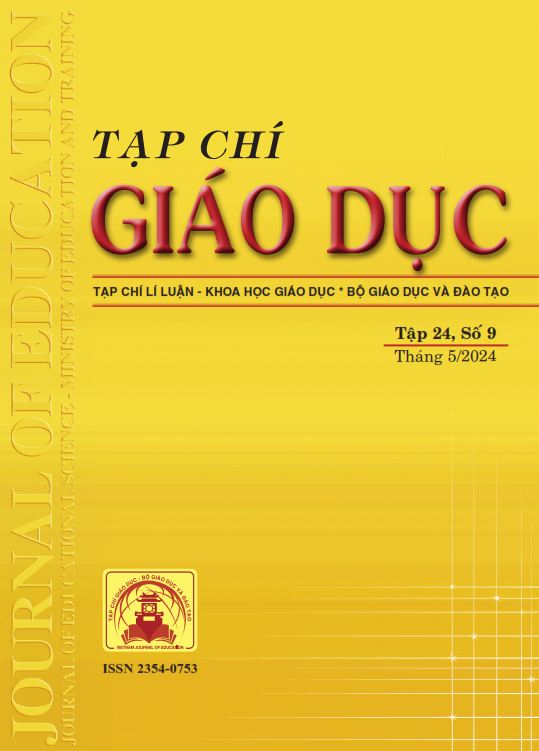Khả năng nghe hiểu từ trái nghĩa trong ngôn ngữ tiếp nhận của trẻ mẫu giáo 5-6 tuổi ở một số trường mầm non tại Thành phố Hồ Chí Minh
Tóm tắt
Listening comprehension in children's receptive language development significantly benefits their language development and maximizes the child’s developmental potential (cognitive, expressive language, social emotions). When children are going through the 5 -6 year old stage, antonyms are one of the mandatory listening comprehension areas in the current Preschool Education Curriculum. Many different word types such as antonymous verbs, adjectives, and prepositions play an important role in supporting children's language development. Therefore, the paper evaluates 5-6 year old children’s antonym listening comprehension ability at some kindergartens in Ho Chi Minh city. Consequently, the professionals can identify and select appropriate antonym listening comprehension assessment methods, learning tools, Or the set of exercises to support development and/or identify areas of delay or difficulty in understanding antonyms.
Tài liệu tham khảo
BộGD-ĐT (2020). Thông tư số 51/2020/TT-BGDĐT ngày 31/12/2020 sửa đổi, bổ sung một số nội dung của Chương trình Giáo dục mầm non ban hành kèm theo Thông tư số 17/2009/TT-BGDĐT ngày 25/7/2009 của Bộ trưởng Bộ GD-ĐT, đã được sửa đổi, bổ sung bởi Thông tư số 28/2016/TT-BGDĐT ngày 30/12/2016 của Bộ trưởng Bộ GD-ĐT.
Gilakjani, A. P., & Sabouri, N. B. (2016). Learners' Listening Comprehension Difficulties in English Language Learning: A Literature Review. English Language Teaching, 9(6), 123-133.
Hasan, A. (2000). Learners’ Perceptions of Listening Comprehension Problems. Language, Culture and Curriculum, 13, 137-153. http://dx.doi.org/10.1080/07908310008666595
Ionescu, A., Lu, H., Holyoak, K., & Sandhofer, C. (2022). Children’s Acquisition of the Concept of Antonym Across Different Lexical Classes. In Proceedings of the Annual Meeting of the Cognitive Science Society (Vol. 44, No. 44).
Jalongo, M. R. (Ed.). (2014). Teaching compassion: Humane education in early childhood. New York: Springer.
Nadig, A. (2013). Listening Comprehension. Encyclopedia of Autism Spectrum Disorders, 1743.
O’Malley, J. M., Chamot, A. U., & Kupper, L. (1989). Listening Comprehension Strategies in Second Language Acquisition. Applied Linguistics, 29, 331-341. http://dx.doi.org/10.1093/applin/10.4.418
Phillips, C. I., & Pexman, P. M. (2015). When do children understand “opposite”? Journal of Speech, Language, and Hearing Research, 58(4), 1233-1244.
Tampubolon, S., Sitorus, N., & Panjaitan, R. K. (2023). An Analysis of Students’ Vocabulary Mastery in Using Antonym of Second Grade Students in SMP Swasta Advent 5 Medan. Journal of Language Education (JoLE), 1(3), 96-102.
Tribushinina, E., van den Bergh, H., Kilani-Schoch, M., Adsu-Koc, A., Dabasinskiene, I., Hrzica, G., … Dressler, W. U. (2013). The role of explicit contrast in adjective acquisition: A cross-linguistic longitudinal study of adjective production in spontaneous child speech and parental input. First Language, 33, 594-616.
Ulfa, M. D., Imamah, S. A., & Angga, S. D. (2019). The Use of Antonym, Homonym, Idiom, and Hyponym in Vocabulary.
Tải xuống
Đã Xuất bản
Cách trích dẫn
Số
Chuyên mục
Giấy phép

Tác phẩm này được cấp phép theo Ghi nhận tác giả của Creative Commons Giấy phép quốc tế 4.0 .












